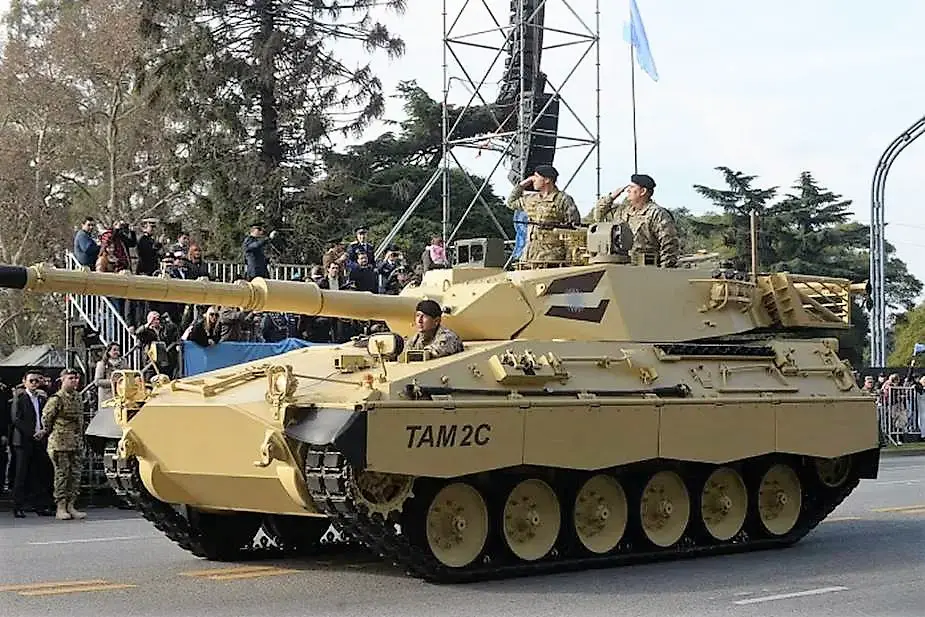According to Joseph P. Chacko in Frontier India, the Ministry of Defense and the Argentine Army have signed an agreement with the company Industrias Mecánicas Pescarmona SA (IMPSA) for the manufacture and modernization of towers within the framework of the modernization project for the Argentine Medium Tank TAM 2C (30.5 ton Tanque Argentino Mediano), the mainstay and most powerful vehicle armoured vehicle in the country.
Follow Army Recognition on Google News at this link

TAM 2C medium tank at Argentine's Independence Day Parade. (Picture source: Argentinian Government)
The contract includes welding services for the supports of the auxiliary power unit and the equipment-carrying bracket of the tower. Work is being carried out at the Arsenals Battalion 602. Argentina plans to ready two to three TAM-2S tanks by the end of the year, Joseph Chacko reports. The initiative has contributions from the National Defense Fund (FONDEF). IMPSA is a local company specializing in high metallurgy and energy generation with clients worldwide.
TAM 2
The Tanque Argentino Mediano (TAM, Argentine Medium Tank) is a medium tank in service with the Argentine Army. Lacking the experience and resources to design a tank, the Argentine Ministry of Defense contracted the German company Thyssen-Henschel. The vehicle was developed by a German and Argentine team of engineers and was based on the German Marder infantry fighting vehicle chassis.
The TAM met the Argentine Army's requirement for a modern, lightweight and fast tank with a low silhouette and sufficient firepower to defeat contemporary armored threats. Development began in 1974 and resulted in the construction of three prototypes by early 1977 and full-scale production by 1979. Assembly took place at the local 9,600-square-meter (103,000 sq ft) TAMSE plant, founded for the purpose by the Argentine government. Economic difficulties halted production in 1983, but manufacturing began anew in 1994 until the army's order of 200 tanks was fulfilled.
The TAM series includes seven different variants, such as a 155 mm (6.1-inch) self-propelled howitzer and a self-propelled mortar vehicle. In total, over 280 such vehicles were built, including armored personnel carriers, artillery and mortar pieces. The TAM and VCTP (Infantry Fighting Vehicles based on the TAM chassis) were manufactured for the Peruvian Army, only to be integrated into the Argentine Army when Peru canceled the contract. The TAM also competed for other export orders, but the TAM was ultimately not exported.
The TAM has never seen combat, although 17 VCTPs were deployed to Croatia for the United Nations UNPROFOR peacekeeping mission.
TAM 2C Project
The TAM 2C project aims to update this combat vehicle with all the technological advances that allow it to fulfill its mission in the most diverse situations it may face. It involves local labour, training of participating personnel and technology transfer, Joseph Chacko reports. TAM 2C upgrades will enable TAM an increased chance of survival, the ability to respond to threats, and the possibility of fighting both during the day and at night.
It was also sought to improve the level of protection of the crew; optimize static and moving shooting accuracy; prioritize the digitization of the control and firing systems, and eliminate the old hydraulic systems for the movement of the turret. Among the main modifications is a new electronic system for movements of the turret and a new digital system for control and implementation of firing.It is estimated that with special ammunition, it can have an effective range of 3,500 m. The special ammunition includes APFSDS shells, a new HEAT shell and the capability to fire LAHAT anti-tank guided missiles.
In early 2021, Argentina and Israel agreed to resume the TAM modernization project, according to statements by the former Argentinian ambassador to Israel, Sergio Urribarri. After a meeting with the director of the International Cooperation Agency of the Israeli Ministry of Defense, Brigadier General Yair Kulas, the Argentinian diplomat, explained that the work would begin that same year and last for the next 5 to 7 years.
Likewise, the ambassador highlighted that the Israeli government assured him that the TAMs would be equipped with modern technology developed during the years that this project was on hold, without this implying an increase in the value of the original contract.














